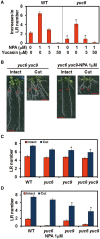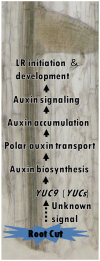YUCCA9-Mediated Auxin Biosynthesis and Polar Auxin Transport Synergistically Regulate Regeneration of Root Systems Following Root Cutting
- PMID: 29016906
- PMCID: PMC5921505
- DOI: 10.1093/pcp/pcx107
YUCCA9-Mediated Auxin Biosynthesis and Polar Auxin Transport Synergistically Regulate Regeneration of Root Systems Following Root Cutting
Abstract
Recovery of the root system following physical damage is an essential issue for plant survival. An injured root system is able to regenerate by increases in lateral root (LR) number and acceleration of root growth. The horticultural technique of root pruning (root cutting) is an application of this response and is a common garden technique for controlling plant growth. Although root pruning is widely used, the molecular mechanisms underlying the subsequent changes in the root system are poorly understood. In this study, root pruning was employed as a model system to study the molecular mechanisms of root system regeneration. Notably, LR defects in wild-type plants treated with inhibitors of polar auxin transport (PAT) or in the auxin signaling mutant auxin/indole-3-acetic acid19/massugu2 were recovered by root pruning. Induction of IAA19 following root pruning indicates an enhancement of auxin signaling by root pruning. Endogenous levels of IAA increased after root pruning, and YUCCA9 was identified as the primary gene responsible. PAT-related genes were induced after root pruning, and the YUCCA inhibitor yucasin suppressed root regeneration in PAT-related mutants. Therefore, we demonstrate the crucial role of YUCCA9, along with other redundant YUCCA family genes, in the enhancement of auxin biosynthesis following root pruning. This further enhances auxin transport and activates downstream auxin signaling genes, and thus increases LR number.
Keywords: Auxin biosynthesis; Lateral root; Polar auxin transport; Root pruning; YUCCA9; Yucasin.
© The Author 2017. Published by Oxford University Press on behalf of Japanese Society of Plant Physiologists.
Figures









Similar articles
-
Auxin signaling modulates LATERAL ROOT PRIMORDIUM1 (LRP1) expression during lateral root development in Arabidopsis.Plant J. 2020 Jan;101(1):87-100. doi: 10.1111/tpj.14520. Epub 2019 Oct 16. Plant J. 2020. PMID: 31483536
-
The jasmonic acid signaling pathway is linked to auxin homeostasis through the modulation of YUCCA8 and YUCCA9 gene expression.Plant J. 2013 May;74(4):626-37. doi: 10.1111/tpj.12152. Epub 2013 Mar 25. Plant J. 2013. PMID: 23425284 Free PMC article.
-
Transcription factor WRKY46 modulates the development of Arabidopsis lateral roots in osmotic/salt stress conditions via regulation of ABA signaling and auxin homeostasis.Plant J. 2015 Oct;84(1):56-69. doi: 10.1111/tpj.12958. Epub 2015 Sep 18. Plant J. 2015. PMID: 26252246
-
The Roles of Auxin Biosynthesis YUCCA Gene Family in Plants.Int J Mol Sci. 2019 Dec 16;20(24):6343. doi: 10.3390/ijms20246343. Int J Mol Sci. 2019. PMID: 31888214 Free PMC article. Review.
-
De novo root regeneration from leaf explants: wounding, auxin, and cell fate transition.Curr Opin Plant Biol. 2018 Feb;41:39-45. doi: 10.1016/j.pbi.2017.08.004. Epub 2017 Dec 11. Curr Opin Plant Biol. 2018. PMID: 28865805 Review.
Cited by
-
Shaping root architecture: towards understanding the mechanisms involved in lateral root development.Biol Direct. 2024 Oct 2;19(1):87. doi: 10.1186/s13062-024-00535-5. Biol Direct. 2024. PMID: 39358783 Free PMC article. Review.
-
Genome-Wide Identification, Expression Analysis, and Potential Roles under Abiotic Stress of the YUCCA Gene Family in Mungbean (Vigna radiata L.).Int J Mol Sci. 2023 Jan 13;24(2):1603. doi: 10.3390/ijms24021603. Int J Mol Sci. 2023. PMID: 36675117 Free PMC article.
-
Rocks in the auxin stream: Wound-induced auxin accumulation and ERF115 expression synergistically drive stem cell regeneration.Proc Natl Acad Sci U S A. 2020 Jul 14;117(28):16667-16677. doi: 10.1073/pnas.2006620117. Epub 2020 Jun 29. Proc Natl Acad Sci U S A. 2020. PMID: 32601177 Free PMC article.
-
Fourteen Stations of Auxin.Cold Spring Harb Perspect Biol. 2022 May 27;14(5):a039859. doi: 10.1101/cshperspect.a039859. Cold Spring Harb Perspect Biol. 2022. PMID: 34400554 Free PMC article. Review.
-
Phosphorus Fertilization and Chemical Root Pruning: Effects on Root Traits During the Nursery Stage in Two Mediterranean Species from Central Chile.Plants (Basel). 2025 Jan 12;14(2):195. doi: 10.3390/plants14020195. Plants (Basel). 2025. PMID: 39861548 Free PMC article.
References
-
- Al-Ghazi Y., Muller B., Pinloche S., Tranbarger T.J., Nacry P., Rossignol M.. et al. (2003) Temporal responses of Arabidopsis root architecture to phosphate starvation: evidence for the involvement of auxin signaling. Plant Cell Environ. 26: 1053–1066.
-
- Beeckman T., Burssens S., Inzé D. (2001) The peri-cell-cycle in Arabidopsis. J. Exp. Bot. 52: 403–411. - PubMed
-
- Benková E., Michniewicz M., Sauer M., Teichmann T., Seifertová D., Jürgens G.. et al. (2003) Local, efflux-dependent auxin gradients as a common module for plant organ formation. Cell 115: 591–602. - PubMed
-
- Biddington N.L., Dearman A.S. (1984) Shoot and root growth of lettuce seedlings following root pruning. Ann. Bot. 53: 663–668.
MeSH terms
Substances
LinkOut - more resources
Full Text Sources
Other Literature Sources

